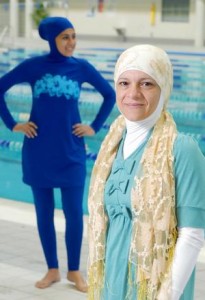Islamic Fashion: A Rebellious Choice
The book Islamic Fashion and Anti-Fashion, focuses on trends, attires, personalities and discourses prevalent in Islamic fashion and proves that Islamic fashion developed as a rupture with the notions of fashion, understood both as an industry with its reckless celebration of female body as well as capitalization of human desires and as ‘pervasive cultural colonialism’ as it is understood in the east.
…………………
When I pen this Review, something similar to the issue in focus, if not connected to it directly, happens in India. Carried away by the enthronement of the Right-wing BJP government at the centre, some ultra-right wing commentators keep arguing that the Muslim names of cities in the country should be weeded out, to be replaced with ‘secular’ Hindu names. Some of them poke fun at ‘Islamic bank’ which, for them, is akin to Islamic state. Not only Islamophobes but Islamophiles are averse to using ‘Islamic’ as adjective. Some say, you should never use Islamic fascism and Islamic fundamentalism. Both these factions might respond in all but similar way, if we throw them the word: ‘Islamic fashion.’

Burqini, is a portmanteau word combining Burqa and Bikini. The trademark of the outfit was registered in 2003 by Aheda Zanetti, gathers significance in the context of sports and games in which Muslim women are participated.
Similar to the expected reaction of the ultra-right wing Islamophobes in India, there occurred protest and demur, when the outfit Burquini was invented. In the brilliant book Islamic Fashion and Anti-Fashion, edited by Emma Tarlo and Annelies Moors, Pia Karlsson Minganti writes about the history of the outfit and the reactions it elicited (See first Essay titled: Burqinis, Bikinis and Bodies: Encounters in Public Pools in Italy and Sweden). Burqini, a portmanteau word combining Burqa and Bikini, “was launched as a sartorial option for Muslim women who cover to enable them to enjoy swimming at public baths or outdoor locations like anyone else without having to compromise what they consider appropriate levels of modesty.” The outfit, whose trademark was registered in 2003 by Aheda Zanetti, gathers significance in the context of sports and games in which Muslim women are participated.
The common reaction to the outfit in Europe was along the expected lines. “In Europe, the opposition to the burqini is to a great extent focussed on it representing some sort of threat to common European norms and values. Real or imagined Islamic norms are presented as fundamentally strange and incompatible with modern European democracy.” Karlsson extends this mindset to deep-seated assumptions and norms that are so patriarchal as to control the mobility of female body by equating it with the Italian censure of nude bathing, expressed through instructions (“Both Muslim veiling and Swedish nudity were inferior to Italian common sense”).
By focusing on trends, attires, personalities and discourses prevalent in Islamic fashion, Islamic Fashion and Anti-fashion proves that Islamic fashion developed as a rupture with the notions of fashion, understood both as an industry with its reckless celebration of female body as well as capitalization of human desires and as ‘pervasive cultural colonialism’ as it is understood in the east. There is in Islamic fashion, the book proves, the feeling of ambivalence akin to that towards modernity. In societies, where orthodoxy determines the subject’s mobility, modernity is often a chance to bypass the proscription. But modernity brings with it its own prescriptions and proscriptions that delimit subject’s freedom and choices. So, how to creatively adapt modernity was the question Islamic modernism has always tried to answer. Similarly, in Islamic fashion, there is a strong reaction to the homogenization of fashion industry and contemporary fashion. But, the novelty and liberation it opens out to women are synchronized with the concept of modesty that Islam lays stress on.
![Helen Latifi: I want it [my clothing style] to match and radiate strength, to reflect the person I am, to express grace, be a little classical, like the person I am inside](http://interactive.net.in/wp-content/uploads/2014/06/helen-latifi-300x168.jpg)
Helen Latifi: I want it [my clothing style] to match and radiate strength, to reflect the person I am, to express grace, be a little classical, like the person I am inside
The book throws sharp focus on the way Muslim women interprets the word modesty in the creative adaptation of the outfit with the concept of being religious and ethical. We read about Kauser Sacranie, designer and CEO of Modestly Active-which, sans caps, has become an appellation denoting activity rather than passivity, coolness rather than the dormancy and choice of beauty as reflection of the inner self rather than the decadent beauty for beauty’s sake. Emma’s interview with fashion blogger Zinah Nur Sharif (also the cover girl of the book), which has been reproduced in the journal with the author’s permission, is another highlight of the book. It shows how Zinah imagines, by both adopting and departing from the mainstream fashion, her own world of fashion.
Based on Saba Mahmood’s work on dress and religious subjectivity and on how dress becomes characteristic of subject’s interiority, Emma Tarlo and Annelies Moors proves, by bringing out this anthology, that both Islamic fashion and anti-fashion have spawned diverse, heterogeneous discourses that can remain corrective to the homogenization of fashion and modernity. The last few pages best encapsulate this position, where photographs of Muslim women in diverse attires are carried. The book, however, restricts its focus to Muslim women and to Europe and North America. But its arguments are relevant in all contexts, as we can encounter similar themes and narrations in all places where Muslims live.
























Connect
Connect with us on the following social media platforms.